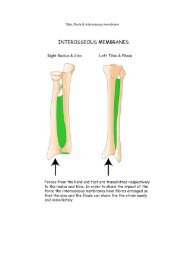GSM 11.11 version 6.2.0 - TTFN Smart card pages
GSM 11.11 version 6.2.0 - TTFN Smart card pages
GSM 11.11 version 6.2.0 - TTFN Smart card pages
- No tags were found...
Create successful ePaper yourself
Turn your PDF publications into a flip-book with our unique Google optimized e-Paper software.
(<strong>GSM</strong> <strong>11.11</strong> <strong>version</strong> <strong>6.2.0</strong> Release 1997)14TS 100 977 V<strong>6.2.0</strong> (1999-05)4.1 Format and layoutThe information on the exterior of either SIM should include at least the individual account identifier and the check digitof the IC Card Identification (see clause 10, EF ICCID ).4.1.1 ID-1 SIMFormat and layout of the ID-1 SIM shall be in accordance with ISO 7816-1,2 [24, 25].The <strong>card</strong> shall have a polarization mark (see <strong>GSM</strong> 02.07 [3]) which indicates how the user should insert the <strong>card</strong> into theME.The ME shall accept embossed ID-1 <strong>card</strong>s. The embossing shall be in accordance with ISO/IEC 7811 [22, 23]. Thecontacts of the ID-1 SIM shall be located on the front (embossed face, see ISO/IEC 7810 [21]) of the <strong>card</strong>.NOTE: Card warpage and tolerances are now specified for embossed <strong>card</strong>s in ISO/IEC 7810 [21].4.1.2 Plug-in SIMThe Plug-in SIM has a width of 25 mm, a height of 15 mm, a thickness the same as an ID-1 SIM and a feature fororientation. See figure A.1 in normative annex A for details of the dimensions of the <strong>card</strong> and the dimensions andlocation of the contacts.Annexes A.1 and A.2 of ISO 7816-1 [24] do not apply to the Plug-in SIM.Annex A of ISO 7816-2 [25] applies with the location of the reference points adapted to the smaller size. The threereference points P1, P2 and P3 measure 7,5 mm, 3,3 mm and 20,8 mm, respectively, from 0. The values in table A.1 ofISO 7816-2 [25] are replaced by the corresponding values of figure A.1.4.2 Temperature range for <strong>card</strong> operationThe temperature range for full operational use shall be between -25°C and +70°C with occasional peaks of up to +85°C."Occasional" means not more than 4 hours each time and not over 100 times during the life time of the <strong>card</strong>.4.3 Contacts4.3.1 Provision of contactsME: Contacting elements in the ME in positions C4 and C8 are optional, and are not used in the <strong>GSM</strong> application.They shall present a high impedance to the SIM <strong>card</strong> in the <strong>GSM</strong> application. If it is determined that the SIM is amulti-application ICC, then these contacts may be used. Contact C6 need not be provided for Plug-in SIMs.SIM: Contacts C4 and C8 need not be provided by the SIM, but if they are provided, then they shall not beconnected internally in the SIM if the SIM only contains the <strong>GSM</strong> application. Contact C6 shall not be bonded inthe SIM for any function other than supplying Vpp.4.3.2 Activation and deactivationThe ME shall connect, activate and deactivate the SIM in accordance with the Operating Procedures specified inISO/IEC 7816-3 [26].For any voltage level, monitored during the activation sequence, or during the deactivation sequence following softpower-down, the order of the contact activation/deactivation shall be respected.NOTE 1: Soft Power switching is defined in <strong>GSM</strong> 02.07 [3].NOTE 2: It is recommended that whenever possible the deactivation sequence defined in ISO/IEC 7816-3 [26]should be followed by the ME on all occasions when the ME is powered down.ETSI








